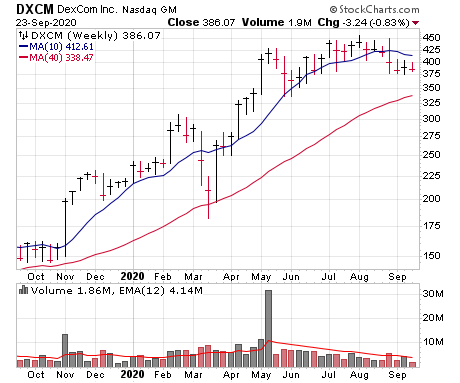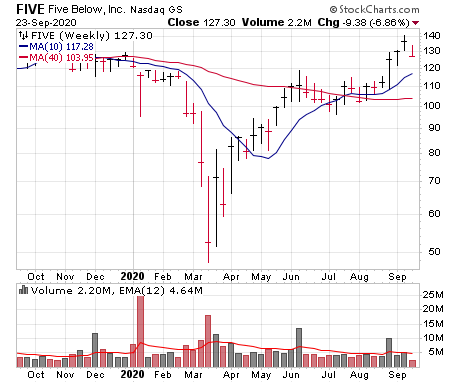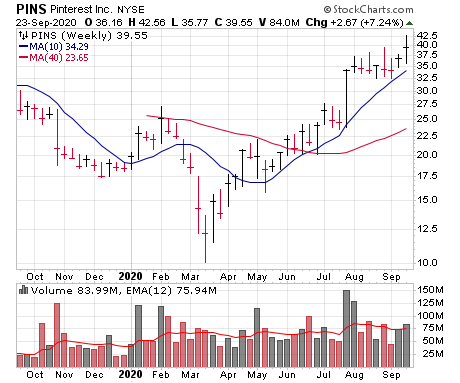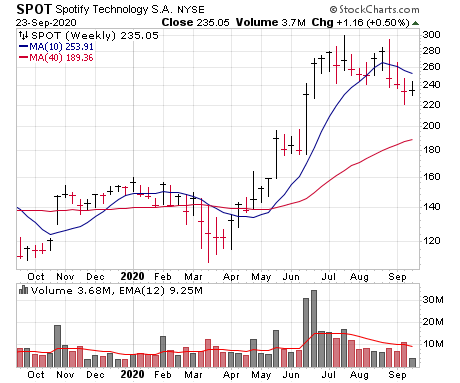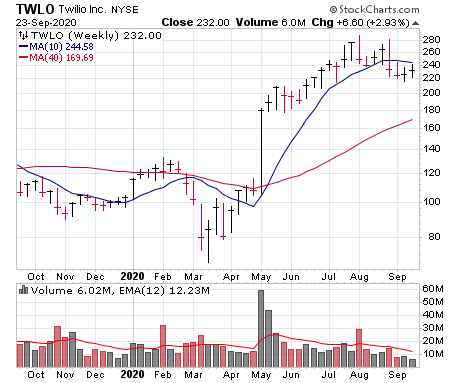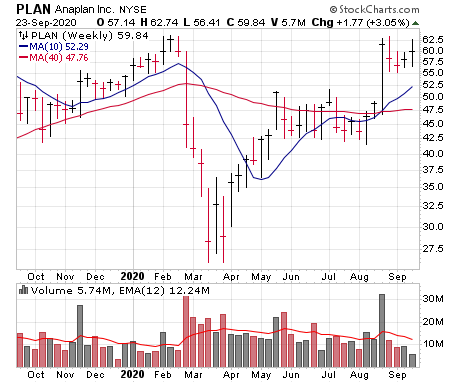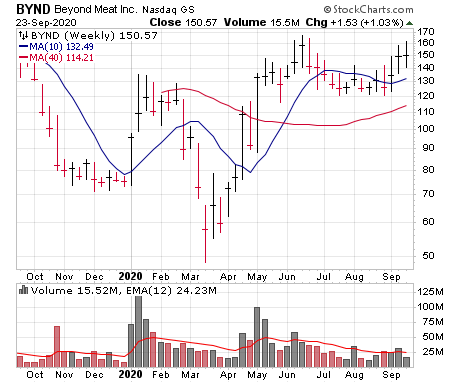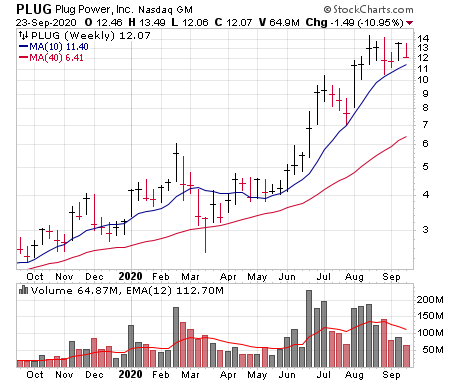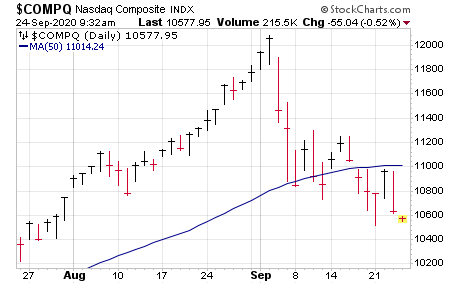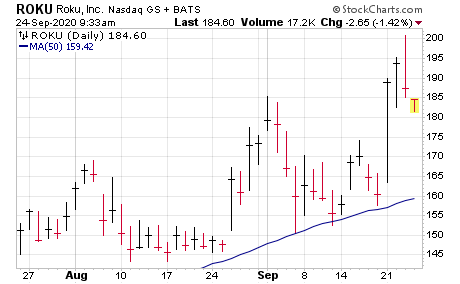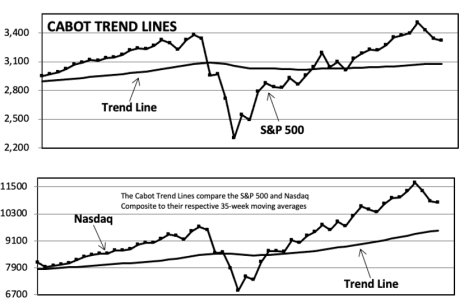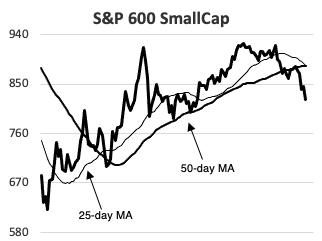The market’s evidence has worsened of late, with our Cabot Tides flipping to bearish earlier this week, and going along with that is a dearth of stocks hitting new highs. To be fair, it’s not all bad news — we’re seeing fresher leadership hold up relatively well, even during this latest decline, while the longer-term signposts are still positive — but we continue to think a relatively cautious stance is appropriate. Since the last issue, we’ve had a couple sells and three buys (repositioning the portfolio into some more resilient names), but we’re still holding onto about 44% in cash.
In tonight’s issue, we go over all our positions (including the new buys, which we think are battling for pole position for the market’s next advance) and talk about one simple chart tool that can help you spot other potential leaders going forward, too.
Cabot Growth Investor 1455
[premium_html_toc post_id="216146"]
Bad News, Good News
Our last issue was titled “Burden of Proof is on the Bulls,” and since then, the buyers have failed to step up to the plate, leading to a worsening of the overall evidence—earlier this week, our Cabot Tides flipped to the bearish side of the fence, telling us the market’s intermediate-term trend is pointed down for the first time since April. Indeed, both the S&P 500 and Nasdaq have fallen more than 10% from their September peaks.
Not surprisingly, the number of stocks that are freewheeling is also subsiding as the indexes have retreated—shown in the chart is the 15-day moving average of the number of stocks hitting new 52-week highs on the Nasdaq vs. the index itself. You can see the average topped out a couple of weeks ahead of the Nasdaq, and today is sitting at its lowest level since late May.
Thus, simply put, the indexes are trending lower in the near-term, and few stocks are letting loose on the upside. That’s the bad news and it confirms that our thinking for much of August and this month was correct—a cautious stance is appropriate as this correction unfolds.
However, there is some good news if you look closely at the action. Back in August, the indexes were strong but the market’s leadership was faltering; taking things on a stock-by-stock basis was one reason we started paring back then. Today, however, we’re seeing a little of the opposite—the indexes are a mess, but there’s definitely a group of new leadership that’s holding up well, with a select few showing big-volume buying here and there. That’s a reason we put a little money back to work last week.
Moreover, longer-term, just about all of the arrows continue to point higher—our Cabot Trend Lines remain firmly bullish despite the recent downmove, we’ve seen little in the way of big-picture abnormal action among individual stocks and there hasn’t been any of the traditional signs (huge surge in new lows off the top, etc.) that typically accompany major market implosions.
Of course, there are never any sure things, especially in 2020; it’s always possible the market falls down a bottomless pit. But we like to play the odds, which favor this being “just” a correction within a new uptrend that got underway in March, so we’re not eager to buy canned soup and lock the storm cellar door.
Really, we think what is most needed is time: The market rallied for more than five months from its lows, including three months after the Nasdaq broke out on the upside, so stocks likely need more than three weeks to scare and wear out the late buyers and set up a new advance.
What To Do Now
Until that new advance comes, we’re content to play it relatively safe, though we’re also not opposed to some repositioning out of “old” leaders and into fresher names. Since the last issue, we’ve sold Spotify (SPOT) and taken partial profits in ProShares Ultra S&P Fund (SSO), but we added stakes in Five Below (FIVE), Pinterest (PINS) and Seattle Genetics (SGEN). All in, that leaves us with a cash position of around 44%.
Model Portfolio Update
It’s been an interesting year to say the least, with lots of divergences, rotation, news-driven moves and the like. And that odd action is continuing—a few weeks ago, the trends of the major indexes were still pointed up but most leaders were looking iffy, and as soon as the market sold off earlier this month, most cracked. Recently, though, we’ve seen the reverse: Earlier this week, our Cabot Tides flipped to negative as the indexes cracked support, but encouragingly, there’s been more positive action among individual stocks now than we were back in August.
That doesn’t mean we’re going to throw caution to the wind—with the Tides negative and very few stocks hitting new highs, it’s still tough to make (and hold onto) profits, with even strong stocks getting yanked lower after a couple of good days. But there’s also a growing batch of fresher potential leaders that are shaping up despite the recent wobbles.
Thus, we’ve been making some moves on both the buy and sell side (including yesterday’s trimming of SSO, aiming to grab a piece of some potential leaders of the next upmove while remaining in a relatively cautious stance (44% cash in the portfolio).
Current Recommendations
| Stock | No. of Shares | Portfolio Weightings | Price Bought | Date Bought | Price on 9/24/20 | Profit | Rating |
| Dexcom (DXCM) | 290 | 6% | 216 | 11/15/19 | 382 | 77% | Hold |
| Five Below (FIVE) | 1277 | 9% | 138 | 9/18/20 | 128 | -7% | Buy |
| Pinterest (PINS) | 2408 | 5% | 37 | 9/18/20 | 38 | 5% | Buy a Half |
| ProShares Ultra S&P 500 (SSO) | 1,741 | 7% | 60 | 5/29/20 | 69 | 14% | Hold 2/3 |
| Roku (ROKU) | 548 | 6% | 170 | 8/28/20 | 178 | 5% | Buy a Half |
| Seattle Genetics (SGEN) | 498 | 5% | 177 | 9/18/20 | 179 | 1% | Buy a Half |
| Spotify (SPOT) | — | — | — | — | — | — | Sold |
| Twilio (TWLO) | 553 | 7% | 174 | 5/8/20 | 238 | 37% | Hold |
| Wingstop (WING) | 1,313 | 10% | 128 | 6/19/20 | 134 | 5% | Hold |
| CASH | $777,679 | 44% |
Dexcom (DXCM 382)—Overall, nothing has really changed with Dexcom, which remains in the throes of a four-month consolidation after a massive run from October (broke out near 180) through May (peak in the 430-440 area). Near-term, we are a bit put off by the stock’s inability to bounce since it got clonked earlier this month; you’d like to see more of an indication that the sellers have been worn out and buyers are stepping up. Fundamentally, nothing much has changed, though the firm is making some marginal inroads here and there—its G6 CGM is now available at Veterans Affairs pharmacies, which will cut costs for patients (most will be 100% covered by the VA) and lessen wait times (used to take two to six weeks to get the G6, this should take just a few days), which will in turn hike demand. We’ll continue to follow our plan, giving our remaining shares of DXCM a decent amount of rope as it works to come out of this tedious (but normal) correction. HOLD.
Five Below (FIVE 128)—We added Five Below last week, and while it’s been caught up in some of the never-ending market rotation in recent days, we still think the trend here has turned up after two years in the wilderness. Of course, the stock will be subject to hopes/fears surrounding economic re-openings across the U.S.; any hiccup in those plans (resurgence of the virus) could hit the entire retail sector, Five Below included. But the bottom line here is that none of the issues of the past couple of years had anything to do with the company itself—the best-in-class store economics (payback of the initial investment in less than a year), which enables a rapid store expansion plan (normally 15%-plus per year, though a bit slower this year for obvious reasons), is still in place, and growth is likely already reaccelerating as the environment slowly returns to normal. Indeed, analysts see earnings doubling next year and leaping well above 2019’s tally. If you don’t own any, we’re OK taking a position here. BUY.
Pinterest (PINS 38)—We think Pinterest has the makings of the next big online winner, with a unique, visual-based offering that provides a different experience than the competition: Whereas e-commerce sites are great if you already generally know what you want, Pinterest allows users to discover what they might want … and, increasingly, pull the trigger on that purchase. The firm is attracting a ton of new users (up 39% in Q2, including many prior users that had dropped off before) that should drive advertising revenues much higher, especially as the company more directly connects users with products. (Product-only searches grew eight-fold in the first half of this year!) Revenues were up just 4% in Q2 as advertisers pulled in, but the future looks very bright, with 30%-ish revenue growth and an earnings lift-off expected in the quarters ahead. We entered a half position last week, and thankfully PINS is off to a decent start—we’ve debated filling out our position, though given the overall market (and the stock’s big swings), we’ll wait on that. BUY A HALF.
ProShares Ultra S&P 500 Fund (SSO 69)—From top to bottom, the S&P 500 has corrected exactly 10%, which isn’t pleasant but, given the run over the past few months, isn’t abnormal-looking, either—given the positive longer-term trend (Cabot Trend Lines) and the blastoff indicators from earlier this year, we continue to think the S&P (and other major indexes) should be nicely higher than here a few months down the road. However, we’re also not going to ignore the fact that, earlier this week, our Cabot Tides flipped to negative for the first time since April, telling us the intermediate-term trend has turned down. Because of that, we decided to take partial profits on SSO in a special bulletin yesterday, selling one-third of our shares for a modest profit. We’ll hold on tightly to the rest as we aim to wait out this correction. SOLD ONE-THIRD, HOLD THE REST.
Roku (ROKU 178)—ROKU is still getting pushed around by the iffy action in growth stocks and the market, but it’s shown some resilience (holding its 50-day line), and earlier this week the buyers came out of the woodwork, booming the stock to new highs on powerful volume. The catalyst: After a lot of back and forth, Roku struck a deal for NBC’s new streaming offering (dubbed Peacock, with thousands of hours of on-demand content as well as live sports and programming) to be available on Roku’s platform. Not only does this add to the platform’s attractiveness, but it goes to show how important its offering has become for streaming providers; you can’t ignore Roku’s reach, which it estimates it totals households with 100 million total people. (At the end of Q2, it officially had 43 million active accounts, but of course many of those are for a family.) Similar to PINS, we’d like to average up here, but given the rough environment, we’ll stick with a half position for now. If you don’t own any, we’re OK picking up a half-sized position on this pullback. BUY A HALF.
Seattle Genetics (SGEN 179)—Biotech stocks have been resting for the past couple of months after nice runs off the March bottom, but now many appear to be resuming their uptrends. Our favorite on the bunch is Seattle Genetics, which has emerging blue chip written all over it thanks to one dominant drug (Adcertis, which is a front-line treatment for a couple types of lymphoma) and two new treatments with huge potential—Padcev was approved late last year for urothelial cancer, while Tukysa (approved earlier this year and sold mostly through digital channels so far) could be a best-in-class offering to battle HER2 breast cancer. And we’re not the only ones who like the prospects: Merck just inked two collaboration deals with Seattle (including selling Tukysa in Asia, Latin America and the Middle East) while taking a $1 billion equity stake in SGEN, too! The stock has popped on huge volume after that news, and it’s continued to act well since; coming after a two-month downmove, we think the trend has turned up. We started last week with a half-sized (5% of the portfolio) position and are sticking with that today. BUY A HALF.
Spotify (SPOT 230)—Bigger picture, we still have hopes that Spotify can get going down the road due to its positive fundamental (new leader in podcasts) and technical (massive-volume blastoff in June) factors, but for whatever reason, it’s not ready to do so here, with lots of selling pressure this month and little ability to bounce. We cut the loss on our half-sized position last week. SOLD.
Twilio (TWLO 238)—Along with most leaders from earlier this year, TWLO has finally gotten off its knees in recent days, a good sign that big investors are starting to support their positions. That said, we’re not popping any champagne bottles yet; shares are still below resistance and there hasn’t been much volume, and there’s been some news on the competition front, with Microsoft’s Azure launching a similar communications service (he stock didn’t react much to that news, though). Overall, nothing has really changed with our thinking—the stock is now eight weeks into a correction/consolidation that the odds favor will serve as a fresh launching pad, though like the overall market, there’s likely more choppy, challenging action ahead before the stock is ready to really get going. HOLD.
Wingstop (WING 134)—We were close to kicking Wingstop out of the portfolio a couple of times in recent weeks, but it never did trip our mental stop (near breakeven in the upper 120s) and it’s finally bounced. That’s not to say it’s out of the woods—there’s plenty of resistance still to chew through and shares are below their 50-day line. But it’s a start, and WING (even during strong uptrends) has a history of multi-week corrections within its advance, so we can’t say what we’re seeing is abnormal. Fundamentally, the question is whether Wingstop has “pulled forward” business that it would have gotten later on—analysts see growth decelerating going forward (earnings up just 12% next year), though it’s hard to put a ton of faith in those numbers given how off they’ve been this year (for understandable reasons). Long story short, we’ll continue to give WING some room to pull out of its recent sluggishness. HOLD.
Watch List
- Beyond Meat (BYND 148): BYND has always had a good story and rapid growth, and now the stock is setting up a tidy launching pad. See more below.
- DraftKings (DKNG 51) and Penn National Gaming (PENN 64): The online casino and (especially) sports betting movement is a huge growth area, and both DKNG (which is smaller and a bit more speculative) and PENN (more stable due to its casinos) look like the leaders in the field. Both have pushed higher nicely—the first pullback or shakeout of a few days could provide an opportunity to get in.
- Elastic (ESTC 105): ESTC continues to hang in there despite issues with many software-related stocks. We think it’s effectively a new-age Big Data outfit with tons of potential.
- Novocure (NVCR 104): Novocure has a potentially revolutionary cancer system called Optune, which uses low doses of radiation (tumor treating fields) to disrupt cancer cells. The stock has ripped to new highs after a year-long rest.
- Square (SQ 152): SQ has a new leg to its growth story (Cash App and Cash Card), and the stock is holding up relatively well after a fresh breakout from a 21-month zone earlier this year. See more later in this issue.
Other Stocks of Interest
The stocks below may not be followed in Cabot Growth Investor on a regular basis. They’re intended to present you with ideas for additional investment beyond the Model Portfolio. For our current ratings on these stocks, see Updates on Other Stocks of Interest on the subscriber website or email mike@cabotwealth.com.
Anaplan (PLAN 59)—Cloud software stocks are in longer-term uptrends, but we’ve seen many 25%-ish corrections in the group every now and then to wash out the weak hands and allow the stocks to rest. That’s the case today, as the group is struggling, but when the buyers return, Anaplan could lead the way. As the firm’s name (and stock symbol) suggest, the firm has what looks like the leading and most powerful digital business planning platform out there, helping managers in a variety of fields (including finance, sales, budget and supply chain) do their jobs better. But this isn’t just an online version of a flow chart—the company has long used proprietary knowhow to help users (not just IT wonks) forecast and do scenario planning, and Anaplan’s new intelligence framework (dubbed PlanIQ) has advanced AI and machine learning capabilities that’s integrated with Amazon Forecast. The need for smarter planning and forecasting is always high, which is why Anaplan has been growing its top line steadily for years. And while growth did decelerate in Q2 (some virus-related headwinds kept growth to “only” 26%), there were plenty of bright spots, including continued growth among current customers (same-customer growth rate of 16%) and remaining performance obligations (all money due to it under contract) rising a solid 36%. Estimates going forward are modest (bottom line still in the red, mid-20% sales growth), but the market is thinking those will prove conservative—after a three-month pause in the 40s, PLAN soared after its Q2 report on its second heaviest weekly volume ever. Just as encouraging, the stock has tightened up just south of its all-time highs despite the damage to the market (and cloud software names in general). The longer PINS can hold up, the greater the chance it will have a good run during the next market uptrend.
Beyond Meat (BYND 148)—We’ve been keeping an eye on Beyond Meat since it came public in April of last year, from its initial giant run (to a high of 240!), to its just-as-giant decline (down to 50 during the crash) and rally after (to nearly 170), when we wrote about the stock three months ago. The company is the leading player in the plant-based meat industry, with burgers, sausages, meatballs, ground beef and more that have been specially designed to have the look, feel and taste of meat-based burgers. Given that meat sales in the U.S. alone are a mind-boggling $270 billion, the potential of healthier (ingredients include beans, brown rice, peas, coconut oil and cocoa butter), plant-based meat is huge—just a couple percent of the meat market in the U.S. would have Beyond growing revenues seven-fold from here! Yes, there’s competition, but there’s certainly room for a few players here, and Beyond continues to make moves (doubled retail distribution for its sausage patties; meatball launch in early October, the third product launch this year; expansion into China; new e-commerce site) to grab more market share. In Q2, food service-related sales plunged as restaurants closed (down 61% in the U.S.), but retail and direct-to-consumer sales picked up steam (up 190%!). Going forward, earnings are expected to leap back into the black in Q3, with 2021 (sales up 61%, earnings up seven-fold) likely to see explosive growth. (Beyond usually tops expectations, so even these figures are likely conservative.) As for the stock, it flashed plenty of big-volume accumulation during its post-crash rebound, and encouragingly, has built a great-looking 14-week base, with little selling volume, tightness near the lows and some buying volume appearing as BYND has perked up. It still has some work to do, but this is really the first legitimate launching pad the stock has etched since coming public—a powerful breakout could be a Go signal.
Plug Power (PLUG 11)—There’s all sorts of buzz and speculation (and shenanigans—see Nikola (NKLA) in recent days) surrounding new-age auto names these days, but one name that’s rarely mentioned is Plug Power, which is very well situated in the fuel cell and (thanks to a recent acquisition) hydrogen market. And this is no pipe dream: At year-end 2019, about one quarter of the groceries in the U.S. were shipped on trucks that use Plug’s fuel cells! Forklifts are also a massive opportunity, with companies including Walmart, Kroger, Sysco and even Fiat Chrysler already customers. In Q2, the firm deployed a record 2,800 of its GenDrive fuel cell systems, bringing the total to around 35,000. It’s also put up about 100 hydrogen fueling stations, too, which is the other leg to this story—Plug is now the largest user of liquid hydrogen in the world, and with the acquisition of United Hydrogen earlier this year, it gets customers coming and going. Long-term, if fuel cell usage increases, Plug thinks the hydrogen side of the business could be larger than its fuel cell revenues! As expected, business slowed down a bit in Q2 (revenues up just 18%), but that’s a one-time blip—billings were actually at a new high in the quarter, and analysts see things bouncing back in Q3 and the top line growing another 30%-plus in 2021. But that’s just the beginning: Plug’s top brass sees the top line growing nearly five-fold from now until the end of 2024, with cash flow surging into the black over time as well. While we’re not normally into lower-priced stocks (names like this have to be handled with care), PLUG has shown fantastic action this year, breaking out in June and holding its 10-week line as it’s pushed higher on big volume. The latest five-week rest is choppy (dipped to the 50-day line today) but normal, especially given the overall environment. It’s an interesting story.
Relative Strength Can Lead You to Future Winners
We’ll take a bull market frenzy any day of the week, with hundreds of stocks fly higher making it easy (well … almost easy) to make good money. But truth be told, when everything is headed up, it’s difficult to tell what the “real” leaders are—a rising tide lifts all boats, after all.
And that’s the one consolation of a down or choppy environment: It makes it far easier to spot what stocks are truly strong, or at least are in pole position to make big moves once the overall market gets its act together. This isn’t some sort of chart voodoo—in fact, we’re not big into fancy chart patterns even during uptrends. Instead, charts are simply glances into supply and demand, telling you what Fidelity, T. Rowe Price and other big mutual fund empires of the world are thinking when it comes to that stock.
Let’s look at the recent chart of the Nasdaq, from the accelerated uptrend through the latter part of summer to the two legs down (one in early September, the other starting late last week). You can use these three points to compare stocks to see which ones are quietly showing strength and which ones are struggling.
(FYI, of the three points in time, the least important is when a stock topped—in fact, many that topped a few weeks ago could be in prime position to get going sooner than others.)
For instance, look at Advanced Micro Devices (AMD), a leading chip player with buoyant earnings estimates. In this case, the stock (a) topped with the Nasdaq in early September, (b) slipped lower initially and (c) has been toying with its 50-day line during this second leg down. All in all, it’s pretty similar to the overall index—a bit better, but nothing overly noteworthy.
But we’re looking for extraordinary, so what we really want to see is recent outperformance, even if it’s subtle. Take a look at Roku (ROKU), for instance—shares broke out just ahead of the Nasdaq peak and were yanked down after that, but held the 50-day line. And last Friday, the stock hit a much higher low (~158 vs. 150) and held its 50-day line (again), even as the Nasdaq slid to lower lows. Thus, when good news hit this week (a deal with NBC—see more earlier in this issue), the stock went bananas; even today’s low was miles above the prior two dips.
Another name that looked similar to Roku before it took off is Square (SQ), one of the new-age payment leaders. Again, it topped the same time as the Nasdaq, but held its 50-day line on the first leg down, and this week, hit a clearly higher low (139 vs. 134)—a sign it wants to head higher if the market can get out of its own way.
Besides the excellent numbers (revenues expected to triple this year, with growth of around 30% next year) and recent relative performance, two things appeal to us about Square. The first is something we’ve seen in numerous big winners (Netflix is the classic example) during the past decade or two—the company has a solid core business but has a new product that should drive growth for years to come. For the core offering, Square’s payment (transaction-related) offerings actually saw gross profit inch higher in Q2 despite the virus headwinds, and should accelerate from here.
But the real excitement surrounds the firm’s Cash App (and associated Cash Card), which is very similar to Venmo for PayPal, effectively creating a separate debit account that allows customers to send and receive money easily and electronically, receive paychecks and tax returns, receive automatic discounts at many merchants (called Boosts) and even invest in stocks. A year ago, Cash App had just a few million users, but by the end of this June, it had 30 million, seven million of which used the Card, too. All in, Cash App produced $281 million of gross profit in Q2, up a whopping 167% from the year before. At the end of the quarter, customers had $1.7 billion of cash balances in these accounts, up 86% from a year ago. As everything goes digital, the potential going forward is massive.
The second appeal here is the big-picture chart—SQ was one of the market’s big winners from 2016 to late 2018, but then spent 21 months bobbing, weaving and diving, scaring and wearing out all the weak hands. Thus, the upmove of the past few months, while sharp, looks more like an initial thrust out of a huge launching pad rather than an exhaustion move. Combine that with the recent resilience and we think SQ should do well once the market gets its act together. It’s on our Watch List. WATCH.
Cabot Market Timing Indicators
Some potential new leaders are holding their own, but the market itself is showing more wear and tear, with our Cabot Tides flipping to a sell signal earlier this week. We’re not sticking our head in the sand, but you should remain in a cautious stance until the sellers finish their work.
Cabot Trend Lines: Bullish
Our Cabot Trend Lines remain bullish but have begun to come back down to earth—the S&P 500 closed last week 7.8% above its 35-week moving average, down from 14.2% three weeks ago, while the Nasdaq closed 12.9% above its own 35-week line, down from 24.3% (!) at the recent highs. After five months up, this correction could easily have longer to run, but with this key indicator positive, the odds strongly favor higher prices in the months ahead.
Cabot Tides: Bearish
Our Cabot Tides flipped to a bearish stance earlier this week, as all five indexes we track (including the S&P 600 SmallCap, shown here) dipped decisively below their lower (50-day) moving averages, confirming the weakness we had been seeing weeks ago in leading stocks. Where things go from here is anyone’s guess, but the red light from the Tides tells us to hold a good-sized chunk of cash.
Cabot Real Money Index: Neutral
Interestingly, as the market has sold off during the past three weeks, nothing has really changed with our Real Money Index—investors are still slowly, steadily pulling money from equity funds and ETFs, so they’re neither buying the dip nor stampeding for the exits. Eventually, money flows should give a good lean-against-the-wind signal, but we haven’t seen it yet.
Charts courtesy of StockCharts.com
The next Cabot Growth Investor issue will be published on October 8, 2020.
Cabot Wealth Network
Publishing independent investment advice since 1970.
CEO & Chief Investment Strategist: Timothy Lutts
President & Publisher: Ed Coburn
176 North Street, PO Box 2049, Salem, MA 01970 USA
800-326-8826 | support@cabotwealth.com | CabotWealth.com
Copyright © 2020. All rights reserved. Copying or electronic transmission of this information is a violation of copyright law. For the protection of our subscribers, copyright violations will result in immediate termination of all subscriptions without refund. No Conflicts: Cabot Wealth Network exists to serve you, our readers. We derive 100% of our revenue, or close to it, from selling subscriptions to its publications. Neither Cabot Wealth Network nor our employees are compensated in any way by the companies whose stocks we recommend or providers of associated financial services. Disclaimer: Sources of information are believed to be reliable but they are not guaranteed to be complete or error-free. Recommendations, opinions or suggestions are given with the understanding that subscribers acting on information assume all risks involved. Buy/Sell Recommendations: All recommendations are made in regular issues or email alerts or updates and posted on the private subscriber web page. Performance: The performance of this portfolio is determined using the midpoint of the high and low on the day following the recommendation. Cabot’s policy is to sell any stock that shows a loss of 20% in a bull market or 15% in a bear market from the original purchase price, calculated using the current closing price. Subscribers should apply loss limits based on their own personal purchase prices.


